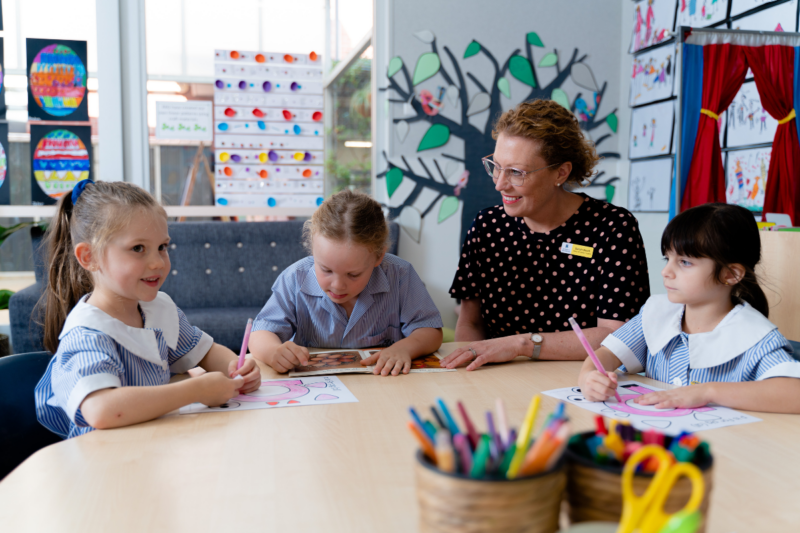How do you know if your child is school ready?
The first day of school is a significant time in our children’s lives and signifies a new and important chapter for your family. This transition can be exciting, but also challenging for your child, as they learn to manage the academic, social and societal expectations and demands of school.
We know through extensive research that children who start school when they’re developmentally ready to learn, tend to have better academic outcomes, and that ‘school readiness’ has a positive effect throughout their education journey.
In 2023, St Peter’s Woodlands has welcomed their first mid-year intake of Reception students, with 19 fresh-faced students starting in the inaugural class in Term 3.
This new mid-year intake allows children who are potentially not quite ready to start Reception at the beginning of the school year to remain in Preschool for an additional six months – instead of 12 months – to consolidate the important skills they will need to navigate the challenges of school life.
The additional flexibility means parents can choose the best time to start school for their child, but this choice can also be difficult for parents if they’re not armed with the right information.
Knowing if your child is school ready can be hard to quantify, so Sarah Noell, SPW Head of Early Years and Deputy Principal, has shared her experience tackling this tricky topic.
The gift of time
A mid-year start can give children more time to become accustomed to their new school environment and provide them with a gentler start to their scholastic journey.
Sarah believes that giving children an extra two terms in Reception to get to know their environment can provide them with an opportunity to be steadily introduced to all of the “school-ready behaviours” and expectations that are part of school life.
“Four terms is quite quick when at school, however six terms gives plenty of time to adjust and build up those skills, such as social & emotional skills so when the rigour of the curriculum begins, they are more ready to successfully learn.” Sarah said.
“Even children who have been enrolled in five days of ELC become fatigued in Reception, because the cognitive load of all aspects and expectations of a school setting is a big change.
“For some children, more time at Preschool and a slower, gentler start to primary school can be hugely beneficial.”
A quick guide to refer to when making the decision if your child is ready for school::
1. Independence skills
2. Language and communication skills
3. Social skills
4. Gross and fine motor skills
5. Attention span
6. Emotional maturity
Beyond the classroom
The transition to Reception is a big leap, no matter your child’s readiness, and many of the challenges our children face are experienced outside of the classroom.
At St Peter’s Woodlands, we feel it is important to consider the whole person when making a decision on the best time to start, which includes more than their academic ability.
“When we look at a day for a new Reception, reading, writing and maths are just a small part of the lessons they are learning,” Sarah said.
“Rather than being in one space with a consistent group of educators in a Preschool program, our Receptions are experiencing specialist lessons with a range of teachers in classrooms across the campus, with larger ratios and differing expectations.
“In PE, they can be loud and active, but in Japanese, they have to remember to take their shoes off and sit quietly on the tatami mats. All these little bits of new information and expectations on their minds and bodies can be exhausting.”
School yards, which are full of children of all ages and abilities playing in the same space, are another new concept that Reception students will have to navigate.
“School yards are full of unspoken processes, like making sure everyone has a turn, and it takes time for young children to learn such rules.
“Monkey bars, for example, are very popular, with specific ways of waiting for your turn and making sure you don’t crash in the middle, so everyone can use them safely.
“You want to ensure children have the social skills to confidently navigate such spaces, and the ability to seek support from yard duty teachers who they might not be familiar with, if they need it.”
There are other additional responsibilities that children are expected to take on, such as looking after their lunchbox and drink bottle, as well as keeping track of school uniform items. Children need a level of independence to manage their belongings successfully.
“Our teachers offer a lot of support to our new students, but these are skills that they will need to practice and learn in the Preschool environment in order to be ready for school.”

The SPW Way
Research tells us that early positive school experiences are important for your child’s social and emotional wellbeing and future academic achievement.
Mindful of the challenges mid-year students may face by starting halfway through the year, St Peter’s Woodlands have adopted a number of additional accommodations to ensure the mid-year intake students have a gentler transition into school.
“Starting school can be a significant undertaking for a child and their families, so we have quite carefully thought through strategies to ensure their first taste of school life is a success,” Sarah said.
Just like the students who begin at the start of the year, the mid-year students will benefit from SPW’s Flying Start Reception Transition Program, which is a considered program that aims to ensure all children feel welcomed, comfortable and excited about their next steps into Reception.
Students will be invited to attend four transition visits to acclimatise to the school environment and to confirm that their allocated classroom is the best fit for them for the rest of the school year. It is also an opportunity for teachers to get to know the students a little better and understand how they can best support their transition.
Reception students only attend four days a week for the first month to ease them into the demands of five-day schooling. Receptions will also be connected with a buddy class of older students who can offer an older, experienced hand and a familiar face in the school yard.
The school is also keen to maintain a connection with ELC friends who will join them in Reception the following year. Regular lunchtime catch ups and other activities have been scheduled to ensure these friendships can continue to develop over Terms 3 and 4.
For mid-year starters, the students are also allowed to wear their PE uniform full time for their first two terms, removing the challenges which can come with buttons and formal uniforms.
Every child is different.
Sarah knows all too well the challenge of this decision, with both of her sons eligible for mid-year intake.
She said that working closely with their Preschool educators helped her to make the right decision for each child.
“My eldest child was so ready to go to school at that mid-year intake. He was like a sponge and so thirsty for knowledge, independent and was ready for the challenges of school. So after consulting with his Preschool educators, we knew he was good to go,” she said.
“My youngest child, on the other hand, was less interested in structured learning tasks. He wanted to play a lot of the time, and was still napping after lunch.
“So we made the decision to give him that extra time.”
Sarah believes educators can be a great guide in making this decision.
“Parents know their child best, but don’t always get to see how their child behaves within an educational setting, where children have to navigate a range of challenges that they may not face elsewhere.
“Early childhood teachers are incredibly experienced and specially trained to support children with this transition, and can be a great sounding board if you have any concerns.
“Virginia Files, our ELC Director meets new school families every year and can also help answer any questions or concerns you may have.”
Sarah also recommends the Raising Children Network website, an online resource developed by the federal government which covers all aspects of childhood development.
“It is a fantastic resource to help parents to consider all aspects of a child’s development, particularly if it is your first child,” she said.
“A lot has changed since parents were in Reception, so it is good to understand what school now expects of children and the latest recommendations from the experts.

Making the best decision for your child
Based on her 25 years of experience, Sarah believes there is no perfect answer to the question, ‘is my child school ready?’ – so whatever decision you make, trust that it will be the right one.
“No one has a crystal ball and no one knows the right path or where the other path may have taken us,” she said.
“You just have to make the decision with as much information as you can and trust, and commit to whatever path you choose is the best path.
“There are ways to support a child through an extra two terms in Preschool (kindergarten), and we have ways to support a Reception child who may be not quite ready for school to ensure they have a positive experience.
“I always believe there is a gut feeling that all parents have of where they think their child should be, but it is so important to discuss the whole child with their Preschool teacher and our admissions staff.”
If you would like to discuss mid-year intake or have any other enrolment questions, please contact Enrolments Manager Jo Gray.